The week at a glance
- Pacific Diver in Cornwall
- Dead American Bittern in Pembrokeshire
- Dead American Purple Gallinule in Bedfordshire
- Dark-eyed Junco (alive!) in Cornwall
The Festive Season sneaked in rather quietly this week as November conceded to December. The opening few days of the final month of the year proved as quiet as the unassuming change from month XI to month XII; the weather was chilly (very chilly in Scotland) with sunshine, snow and rain all adding to the damp squib party atmosphere. There were very few true megas to report either, with half of the headline-makers this week sadly deceased.
Top billing this week goes to the adult Pacific Diver seen again in Mount's Bay (Cornwall) on 3rd. Having been seen as a "possible" and a "probable" in mid-November, this is the first time that the bird has been confirmed in the bay this winter. The bird was first seen around Penzance in February 2007 and returned in late November last year. The marshy surrounds of St. David's Airfield (Pembrokeshire) proved to be the final resting place of an American Bittern, whose remains were picked up there on 30th. Quite how long the bird had been there is a tricky thing to guess at, but the wing at least appeared in reasonable condition, so it seems likely that it may have arrived this autumn. This represents the fourth record for the county, and the first since 1946. The most recent twitchable American Bittern was the marvellous bird at Marton Mere in Lancashire during the winter and spring of 1991. Since then there has been just one more accepted record, a bird seen (and photographed) on the Camel Estuary (Cornwall) on 13th–17th May 1999. From Bedfordshire this week came news of an even rarer transatlantic vagrant — an American Purple Gallinule, found on the Southill Estate during the spring, "roosted" in a freezer for a few months and then shown to a patch-worker carrying out some survey work. The bird — seemingly a first-summer — appeared to be in good condition and despite the (at first) curious location, there's no reason to think that the bird couldn't have got here under its own steam. Plenty of other Nearctic vagrants have turned up in odd places and the bird may have spent the whole of last winter in Bedfordshire! Equally it may even have been heading back north after wintering further south. Who knows? The only accepted British record was of a moribund bird found in a Hugh Town gutter on St. Mary's (Scilly) in November 1958. At one point this week it seemed as though the Steppe Grey Shrike at Grainthorpe Haven (Lincolnshire) had become an ex-Steppe Grey Shrike — there was no sign of the bird after the 26th and then some feathers were found on site which initially were suggested as having come from the Shrike. Subsequent BTO examination said "no" — the feathers were definitely not from the hugely popular rarity, and it was a fox rather than raptor that had done for the unnamed species. Hopefully the Shrike is hale and hearty somewhere. Belated news emerged on 2nd of a Dark-eyed Junco feeding in a garden in Hayle (Cornwall) on 26th November, presumably a new bird, or maybe it was the bird seen recently in Somerset dropping further down the country.
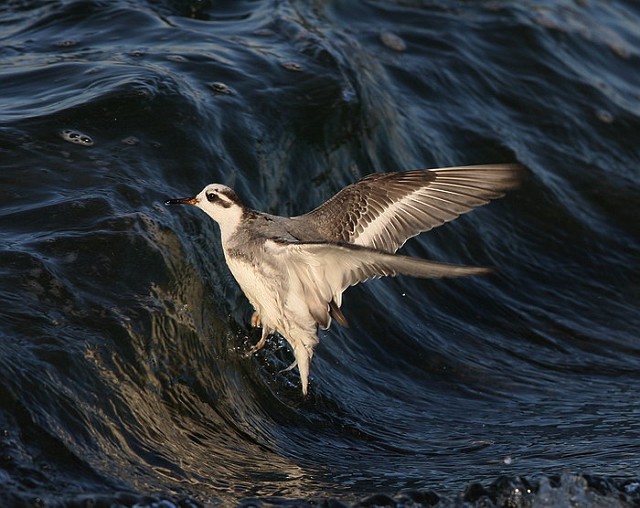
Grey Phalarope, Covenham Reservoir, Lincolnshire (Photo: Dean Eades)
The adult White-billed Diver was still to be seen in the waters off South Ronaldsay (Orkney) on 28th and 2nd. For the first time in weeks, Grey Phalaropes could only manage a couple of birds: one remained at Cley Marshes (Norfolk) to 27th and another was still being seen at Covenham Reservoir (Lincolnshire) on 28th–3rd. A juvenile Long-tailed Skua spent a few minutes off Landguard (Suffolk) on 30th, while a handful of Pomarine Skuas included two from Berry Head (Devon) on 27th (with a Balearic Shearwater there the same day). In Shetland, 26 Little Auks flew past Sumburgh Head, Mainland on 1st.

Cattle Egret, Barton-under-Needwood, Staffordshire (Photo: Richard Pegler)
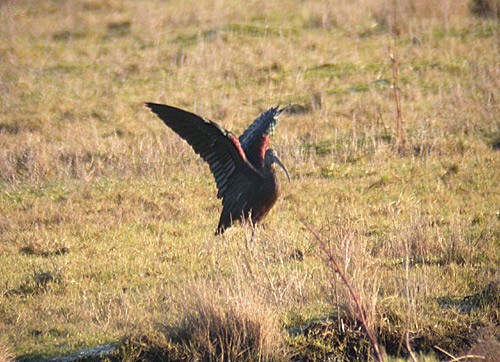
Glossy Ibis, Marshside RSPB, Lancashire (Photo: Neill Hunt)
Three Cattle Egrets were still to be seen in Cumbria this week: the single bird at Urswick was present to 27th while the twosome near Milnthorpe remained to 29th at least. On 29th, a Cattle Egret was seen at Barton-under-Needwood (Staffordshire) and stayed to 2nd, but it appears that the bird had been present since 6th November. Another bird that has been around a while was the Cattle Egret seen at Shell Ness (Kent) on 30th, this bird present for a fortnight or so. The 30th also saw single birds noted at Haversham (Buckinghamshire) and Leighton Moss (Lancashire) while, also in Lancashire, two birds were reported from Preesall. Five Cattle Egrets were at Walton (Somerset) on 2nd and one was at Romsey (Hampshire) on 3rd. In County Cork, a Cattle Egret remained at Inchydoney Bay to 1st. The Great White Egret was still at Blashford Lakes (Hants) to 2nd, while in Greater Manchester the Great White Egret there moved to Wigan on 28th–29th, within the gaze of the JJB Stadium (maybe the roar of Wigan's winner against West Brom's relegation-bound Throstles made it up sticks). There's a whole new listing game for someone, noting rarities seen at or near football stadiums: Great White Egret near the JJB, Laughing Gull by Reading's Madejski Stadium, White Stork over Rochdale's Spotland Stadium.... Back in the real world, a dozen or more Spoonbills were again around Arne (Dorset) this week, with six still up in north Devon at Isley Marsh. Single birds were seen at Cliffe Pools (Kent) to 29th and at St. John's Lake (Cornwall) on 30th. The Glossy Ibis was at Warton Marsh (Lancashire) from 28th–1st before reappearing at Marshside on 3rd, while Common Cranes included two over the police station at Downham Market (Norfolk) on 27th, six at the Broadland roost at Stubb Mill (Norfolk) on 29th and two at Lakenheath (Suffolk) throughout the week. Another Common Crane was seen at Durrus (Co. Cork) on 1st.

Snow Goose, Holywell Pond, Northumberland (Photo: Michael)
The adult Red-breasted Goose remained around the marshes of Hampshire this week, being seen at Oxey Marsh on 28th and Normandy Marsh on 29th–3rd. A Richardson's Canada Goose was still on Berneray (Outer Hebrides) on 29th and a probable Cackling Canada Goose was on Islay (Argyll) on 2nd. The Northumberland Snow Goose was at Holywell Dene and Pond from 27th–28th before moving to East Chevington and Druridge Pools on 29th–2nd. In Norfolk, a Lesser Snow Goose was at Repps near Great Yarmouth on 30th. The probable Grey-bellied Brant was still being seen on the Gann Estuary (Pembrokeshire) to 30th, while two Black Brants were again on the Fleet (Dorset) on 28th, with single birds at Titchwell (Norfolk), Faversham (Kent), the North Slob (Co. Wexford) and Dungarvan (Co. Waterford) during the week.
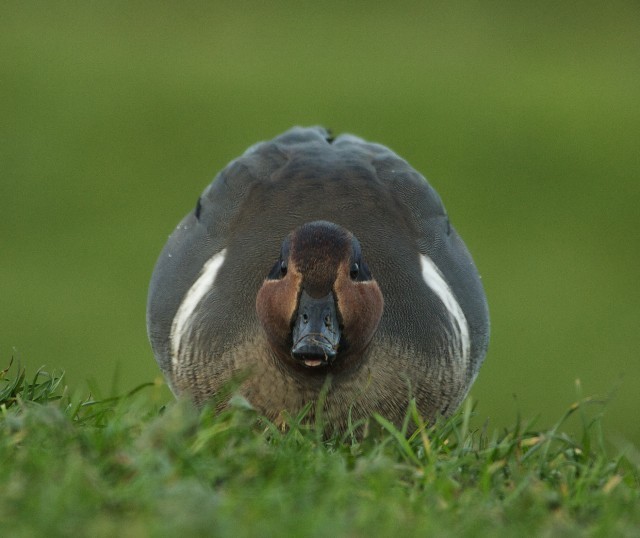
Green-winged Teal, Belfast Lough RSPB, Antrim (Photo: Danny Boyd)

King Eider, Bluemull Sound, Shetland (Photo: Brydon Thomason)
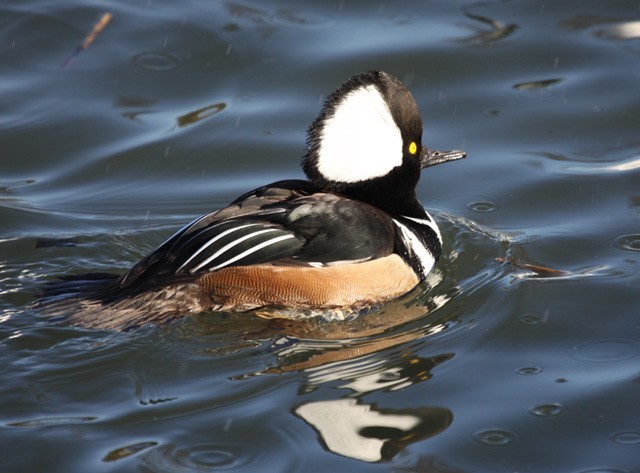
Hooded Merganser, Radipole Lake RSPB, Dorset (Photo: Simon Kidner)
A new first-winter drake Lesser Scaup was seen this week, at Quoile Pondage (Co. Down) on 29th–30th, and the young drake was still at Frampton-on-Severn (Gloucestershire) to 3rd. The adult drakes at Holme Pierrepoint (Nottinghamshire) and Hogganfield Loch (Clyde) were both present again for much of the week, and the female at Loe Pool, Helston (Cornwall) was seen to 3rd. The drake Ring-necked Duck was at Foxcote Reservoir (Buckinghamshire) on 30th–1st and the drake was again on Loch Bhasapol, Tiree (Argyll) on 20th. A pair of Ring-necked Ducks were seen on The Gearagh (Co. Cork) on 30th (the female being seen the previous day) and, on 3rd, a drake Ring-necked Duck was on Lough Gash Turlough (Co. Clare). Single drake American Wigeon were at Lower Farm Gravel Pits (Berkshire) on 27th–28th and Wick (Highland) on 1st. There was a slight rise as far as Green-winged Teal were concerned this week, with Scotland bagging six, Ireland three and England one. Scottish birds included new finds at Loch of Tankerness, Mainland (Orkney) on 28th, Douglas Water (Clyde) on 30th and Tain (Highland) on 3rd, with long-staying individuals still at Capringstone Flash (Ayrshire), Caerlaverock (Dumfries & Galloway) and Kinneil Lagoons (Forth). Irish birds were all familiar ones, at Belfast Lough (Co. Antrim), Kilcoole (Co. Wicklow) and Bell Harbour (Co. Clare), while the sole English record was at Marshside (Lancashire) on 1st–2nd. Single drake Surf Scoters were seen at Ruddon's Point (Fife) on 28th, the Bay of Kirkwall (Orkney) on 30th and in the Sound of Taransay (Outer Hebrides) on 2nd, with females remaining at Hough Bay, Tiree (Argyll) on 29th–3rd and Dawlish Warren (Devon) to 3rd. A female King Eider was in Bluemill Sound (Shetland) on 28th. After a few weeks in the spotlight, it's time to demote the drake Hooded Merganser at Radipole Lake (Dorset) to the lesser heights of "also-ran" rather than "mega"; the provenance of the bird is (like all Hooded Mergansers) nigh-on impossible to prove, but for some, the feeding with Mallards and taking bread like a tame bird has become too much! It all smacks of Peasholme Park, Scarborough now, and that splendid drake was deemed "duff" for displaying many of the same traits that this, arguably, habituated individual now shows. The bird remained to 3rd.
A juvenile Gyrfalcon landed on a trawler well off the coast of County Kerry on around 27th and was subsequently taken into care with the hoped-for release date still "tbc". The second-winter Rough-legged Buzzard was still at Reed (Hertfordshire) throughout the week and the bird at Farforth (Lincolnshire) was present to 28th. At Pocklington (East Yorkshire), two birds were seen on 27th with one there on 30th and 3rd. In Kent, a Rough-legged Buzzard was at Capel Fleet, Sheppey on 1st when one was seen in North Yorkshire, at Thorganby Ings. A juvenile Rough-legged Buzzard was near Hickling village (Norfolk) on 3rd.
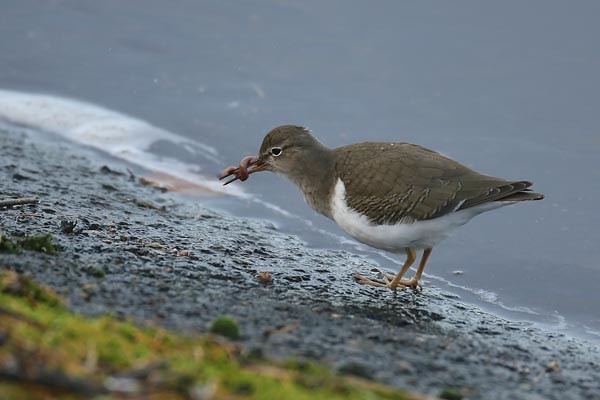
Spotted Sandpiper, Tittesworth Reservoir, Staffordshire (Photo: R.L.Brown)
The first-winter Spotted Sandpiper at Tittesworth Reservoir (Staffordshire) was present from 27th–2nd. In Lincolnshire, the White-rumped Sandpiper at Alkborough Flats was seen again on 30th. The adult Long-billed Dowitcher was seen again in the docks at Dundalk (Co. Louth).
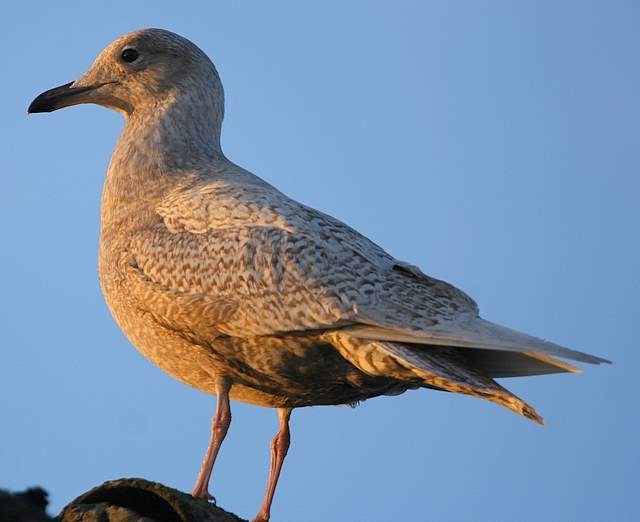
Iceland Gull, Blyth, Northumberland (Photo: anon)

Glaucous Gull, Minsmere RSPB, Suffolk (Photo: Richard Ford)
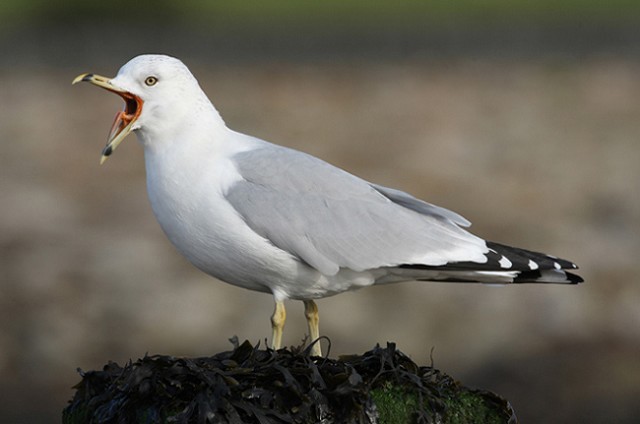
Ring-billed Gull, Westcliff-on-Sea, Essex (Photo: Steve Arlow)
An adult Bonaparte's Gull was seen on the estuary at Rosscarbery (Co. Cork) on 1st. Around 18 Caspian Gulls were noted this week: "twos" were at Stubber's Green (West Midlands) and Moore Nature Reserve (Cheshire) on 28th and Rainham Marshes (London) on 1st, with notable singles at Bishop's Cleeve (Gloucestershire) on 27th and Linford (Buckinghamshire) on 29th and 3rd, while the third-winter was still being seen every evening at Potteric Carr (South Yorkshire) to 2nd. Numbers of Iceland Gulls dropped this week from just under 50 to just over 30 — three birds were seen in Orkney, Ayrshire and County Galway. Glaucous Gulls fell further still, from some 50+ last week to just 14 this week. Two birds were seen on Shetland, while a juvenile around Cley and Salthouse to 3rd proved popular. Single new adult Ring-billed Gulls were found at Angle Bay (Pembrokeshire) on 27th (remaining in the area to 2nd at least) and in Dundee on 2nd (this bird still present on 3rd). Two "new" second-winters were also found during the week, at Whitehouse Lagoons, Belfast (Co. Antrim) on 2nd and on Hampstead Heath (London) on 3rd. These four birds aside, it was mainly returning adults that dominated, adults at Oban (Argyll), Westcliff-on-Sea (Essex), Isle of Dogs (London) and Gosport (Hampshire) being all very familiar now, while the returning second-winter at Lamby Lake (Glamorgan) and first-winter at Helston (Cornwall) continued to offer something a little different. Two adults were at Nimmo's Pier (Co. Galway) off and on throughout the week.

Great Grey Shrike, Lakenheath, Suffolk (Photo: Robert Wilson)
After a day or two going AWOL, the super first-winter male Desert Wheatear was seen again at Girdle Ness (Aberdeenshire) on 29th–30th. In County Galway, the Hoopoe was at Traught Beach to 27th and a Richard's Pipit was at Sandwich Bay (Kent) on 2nd. Great Grey Shrikes were seen in reasonable numbers again this week — on 27th, one was reported near Bridgwater (Somerset) and the bird at Lakenheath (Suffolk) was seen again (remaining to 2nd at least). A second Suffolk bird was seen at Santon Downham, also on 27th. On 28th–29th, a Great Grey Shrike was seen at Denver Sluice (Norfolk) and further singles on the latter date were in the New Forest (Hampshire), again at Ramsley Reservoir (Derbyshire) and Oakers Wood (Dorset). The 30th saw a Great Grey Shrike at Langdale Forest (North Yorkshire) and another (perhaps the Santon Downham bird?) move to Grime's Graves (Norfolk). The wintering bird at Wishmoor Bottom (Berkshire) was seen on 1st; on 2nd, one was at Westmarsh (Kent); and on 3rd a Great Grey Shrike was seen in Somerset, on Exmoor, near Webber's Post.
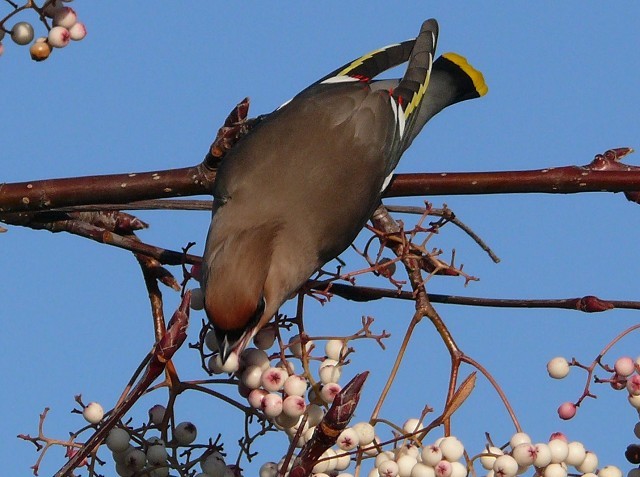
Waxwing, Lincoln, Lincolnshire (Photo: Zoe Shreeve)
Waxwings continued to be seen countrywide this week, and it was still Scotland that laid claim to the largest numbers of birds. On 27th, in Lothian 120 were seen at Musselburgh, with another 100 at Joppa. At least 500 were still around Glasgow (Clyde) on 27th, including 400+ on Fulton Street. On 28th, the flock in Musselburgh had risen to 380+, with at least 200 in nearby Edinburgh (Lothian). A further 100 were at Linlithgow (Lothian) on 29th (rising to 200+ on 30th) and 200+ were still around Hamilton (Clyde) on the same date. Yet another Lothian three-figure tally came on 30th, with 100 at Fairmilehead, and 350+ were still in Glasgow. On 3rd, at least 207 were seen in Paisley (Clyde). In the northeast, 185+ Waxwings were at Stockton-on-Tees (Cleveland) on 30th, with several flocks of 20 or more dotted around the region, including 60+ at Halifax (West Yorkshire) on 27th and 80 at Portrack Marsh (Cleveland) on 30th. In the northwest, 107 birds were seen at Dalston (Cumbria) on 27th, 80+ were in Preston (Lancashire) on 29th and 120+ were in Penrith (Cumbria) on 3rd. Many smaller flocks were noted throughout the week. One bird made it to Ramsey (Isle of Man) on 28th–30th, with eight at Ballalough, Andreas on 3rd. In the southeast, 23 Waxwings were at Itchen Valley Country Park (Hampshire) on 27th and 21 were seen on Hayling Island (Hampshire) on 1st. East Anglia and the Midlands fared less well, with around 30 birds in the former and around 35 in the latter; 15 at Bestwood (Nottinghamshire) on 30th was the highest total noted. There were three birds in Wales this week, at Newtown (Powys) on 3rd. In Ireland, 100 birds were seen in Lisburn (Co. Down) on 1st following on from 80 at Coleraine (Co. Derry) on 27th.
In County Wexford, the Barred Warbler at Fethard-on-Sea was last seen on 26th and what may have been the same bird as that seen at Kilmore Quay on 29th. Two single Yellow-browed Warblers were seen in Cornwall this week, at Nanjizal on 28th and St. Just on 2nd. Next door in Devon, a Yellow-browed Warbler was present at Salcombe on 29th–1st, while two more singles were in Glamorgan this week, at Maesteg on 1st and at Summerhouse Point on 2nd. A Pallas's Warbler has been reported from the Isle of Wight "recently", east of Newport, but no further details have been available. Bedfordshire's first Red-breasted Flycatcher remained at Leagrave Marsh until midday on 29th.

Penduline Tit, Attenborough NR, Nottinghamshire (Photo: Sean Browne)
A male Penduline Tit was a great inland find at Attenborough Pits (Nottinghamshire) on 28th, remaining only until the following day. This was the second record for the county; the first, also at Attenborough, was in October 1994. The first Coues's Arctic Redpoll in Essex since 1996 was found at Thorndon Country Park on 1st, and was still present (amongst a large mixed flock of 400 redpolls) on 2nd. A Serin spent a day at the London Wetland Centre on 28th and one was still at Rainham Marshes (London) on 3rd. Also on 3rd, the Common Rosefinch was still being seen in and around Whitburn (Co. Durham). The juvenile Rose-coloured Starling was still in Newquay (Cornwall) from 27th–1st while, finally this week, last week's trapped and ringed Little Bunting at Knott End (Lancashire) was reported twice, very briefly, on 27th.
Photo of the Week

Mistle Thrush, Barrow, Lancashire (Photo: Annette Cutts)
Mistle Thrushes are well known for their aggressive tendencies towards each other and towards other species. As is often the case, though, there is a big difference between a behaviour being well known and it being captured on camera. This week, Annette Cutts has sent us our first image of Mistle Thrush aggression, with a great action shot of two birds fighting for ownership of a row of rowan berry trees. Freezing the two birds in extreme poses with a strong vertical line of eye contact, Annette has captured the event in a dynamic composition.
Other notable photos
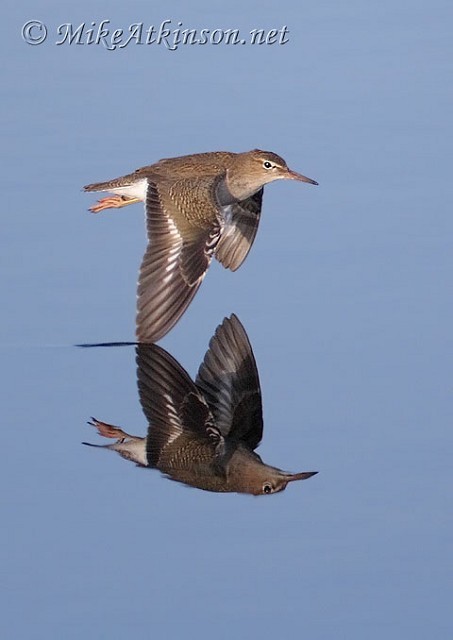
Spotted Sandpiper, Tittesworth Reservoir, Staffordshire (Photo: Mike Atkinson)

Waxwing, Salthouse, Norfolk (Photo: Nigel Pye)

Herring Gull, Lerwick, Mainland, Shetland (Photo: Robbie Brookes)

Bar-tailed Godwit, North Wirral CP, Cheshire (Photo: Richard Steel)

Pink-footed Goose, undisclosed site, Lancashire (Photo: Tom Charles)

Coal Tit, Forest of Dean, Gloucestershire (Photo: Lewis Thomson)

Desert Wheatear, Girdle Ness, Aberdeenshire (Photo: Dougie Preston)

Woodcock, Lamba Ness, Unst, Shetland (Photo: Robbie Brookes)

Black Grouse, undisclosed site, Perth & Kinross (Photo: John Anderson)

Barn Owl, undisclosed site, Lancashire (Photo: Brian Rafferty)

Great Spotted Woodpecker, Attlebridge, Norfolk (Photo: Nigel Pye)
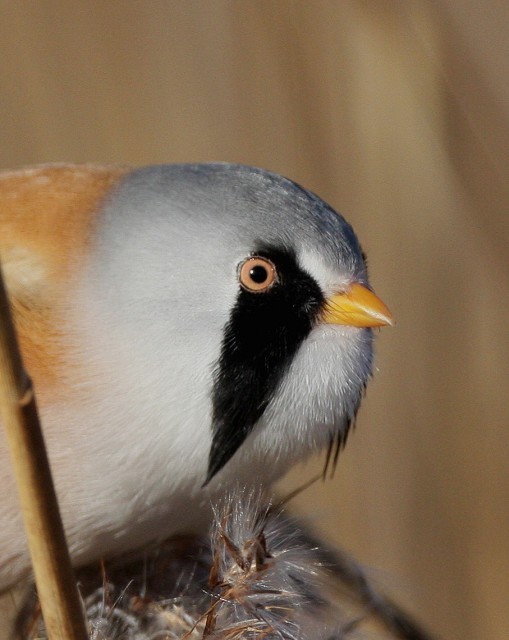
Bearded Tit, Cosmeston Lakes CP, Glamorgan (Photo: Stevehinton)

Common Kestrel, Hythe, Kent (Photo: anon)

